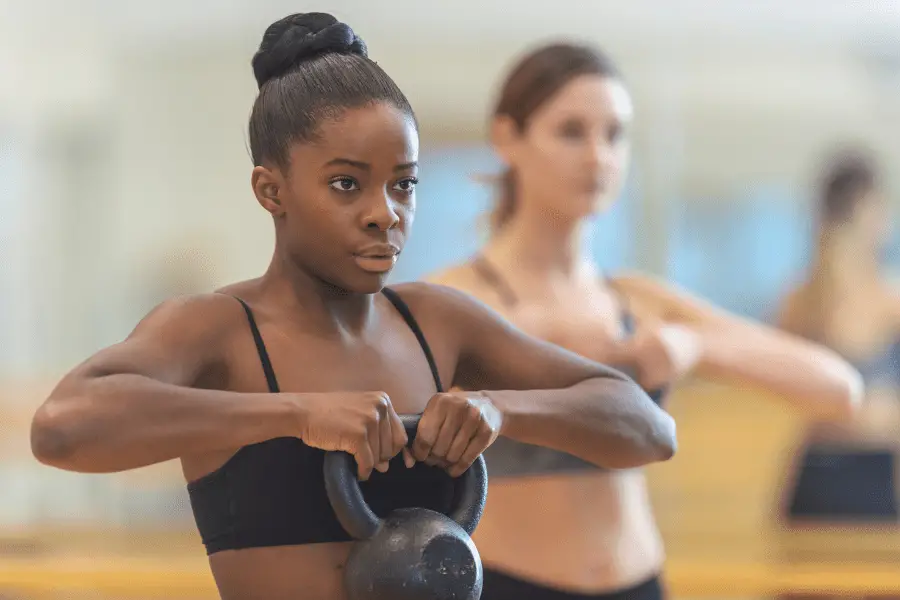Address
304 North Cardinal St.
Dorchester Center, MA 02124
Work Hours
Monday to Friday: 7AM - 7PM
Weekend: 10AM - 5PM
The shoulder muscles are a very important part for looking strong and muscular. It’s the widest part of your body and making them even wider will make you look stronger and give your physique a better V-shape. But how many workouts a week is enough to make that growth happen? Here’s what you need to know.
Two workouts a week is the minimum amount to grow your shoulder muscles. Three workouts a week can give better results but might compromise the training of other body parts. Two shoulder workouts a week with the right intensity is the sweet spot between growth, recovery and time for most people.
Why is that and what do you need exactly to grow your shoulders? Keep reading below to find out.
So let’s say you want to grow your shoulders. That is why most people target their shoulders directly anyways. Most people want to have the impressive v-shaped physique and wide shoulders are a big part of that. Nothing wrong with that just don’t forget the other muscles. Anyways, is two workouts a week enough to grow your shoulders?

For maintenance, one shoulder workout a week with a good amount of volume and intensity will be enough. However, to get some good growth at least two workouts a week is recommended. Two workouts a week with proper intensity can be enough for the shoulders to grow although if you really want to focus on the delts, three might work better. Two workouts a week is going to be enough for the majority of people though. Three workouts will likely start cutting into the time and attention you can give to other body parts so that’s a decision you’ll have to make yourself.
The shoulders do need a lot of training volume per workout to grow. A full shoulder workout will take some time so two a week is a good amount of time already. Three workouts takes up a lot of your weekly workouts.
The deltoids recover quite quickly and are actually hard to damage with training which is why they can handle more than most other muscles. Most muscle growth happens in the first 24-48 hours after a workout. Bigger muscles can take longer but the delts are relatively small so they recover quite fast. With a 48 hour rest in between workouts, you could fit in 3 workouts a week.
More than three workouts is possible but you’ll have to significantly cut the amount of work you do per workout and for most people this is not a practical nor efficient use of their time and energy. With more than three workouts, you’ll see diminishing returns for every extra workout. So for moderate growth, two workouts a week is the sweet spot and for significant growth, three a week is good.
The deltoids are used for many other exercises besides direct shoulders exercises. Pretty much all pushing and pulling exercises use the shoulders to complete the movement. For pushing exercises, the target muscles might be the chest or arms but you can’t do them without using the front/side deltoids. Most pulling exercises will use the rear delt to some degree. That means they do get some stimulation if you follow a full body workout routine, even before targeting the shoulders directly. However, to grow, you’ll have to add extra targeted work.

It’s good to understand there are actually three parts to the shoulder muscles; front, side and rear deltoids. The names are pretty self explanatory. The front deltoid sits on the front of the shoulder, the side on the side and the rear on the rear.
The front delts usually get enough of a workout with pushing exercises and beginners/intermediate lifters don’t have to add specific exercises for the front delts.
The side and rear deltoids are not so lucky however. They’ll need targeted work to grow. And you’ll have to target them separately because they don’t often work together much. Also, for optimal growth BOTH muscles should get two workouts a week. So doing the side on one day and the rear on another is not the best option. Doing both on both days is better.
In absolute beginners, doing pulling exercises is often enough to grow the rear delts even without having to do any direct deltoid exercises. However, after you’re not an absolute beginner anymore, some direct rear deltoid work is necessary for gaining muscle because the pulling exercises alone don’t provide enough of a training impulse to the body.
The side deltoids need a lot of direct training volume to grow right from the beginning. Overhead pressing and lateral raises are a must do if you want to get that wider look.
Since you’re already using the shoulders for pushing and pulling exercises, you can add on a shoulders workout after a push and/or pull workout. That way you can skip the warm up sets and save some time. I would recommend doing it at the end of the workout otherwise you might not be able to properly do the other exercises.
As you might understand from above that two deltoid workouts (with deltoid isolation exercises) is enough to build muscle. One more workout a week might help you grow more but you’ll notice diminishing returns and potential recovery issues. More than 3 workouts a week is going to be problematic for many people if you do a decent amount of volume per workout.
However, one thing to understand is that the amount of workouts doesn’t say much. Compare two people working out the same body part in any gym and there will be big differences in amount of sets, repetitions, weight and effort. One moves his arms up and down 3 times without weights, the other does 8 heavy sets of shoulder presses. Those two people will have visibly different results in the future. However, more isn’t always better either.
So what do you actually need to grow your shoulders?
There are four main factors you should get right;

As said above, there are many exercises that use the shoulders. Most pushing exercises will use the shoulders. But to really grow the delts, you have to do some isolation exercises on top of that. So things like incline bench pressing and dumbbell presses don’t count. Look at exercises like the dumbbell lateral raise.
The deltoids extend the shoulder joint so that’s exactly what you have to do to isolate those muscles. There are still a ton of different ways to do that though. Use a selection of 2 different exercises that directly target and isolate the shoulders. Keep in mind, you have three different muscles in the shoulder; Front, side and rear deltoids. The front is usually trained enough through other pushing exercises like the bench press and even overhead press. Most people don’t require extra exercises for the front delt until they’re more advanced lifter. It’s better to focus on the side and rear deltiods. The side gives you a wider look while the rear adds ‘thickness’ to the shoulder.
The two muscles are not usually targeted directly so you’ll have to pick exercises for those separately. The rear delts are often used for pulling exercises but most people can benefit from adding one or two isolation exercises.
That means a full shoulder workout will have two exercises for the side delts (overhead press and lateral raise for example) and two other exercises for the rear delts (reverse fly and face pull for example.) You can of course switch up the exercises between workouts.
The amount of sets you do per workout and week is a very important variable for muscle growth.
For the side delts, 8 heavy sets a week is the minimum to see some growth. For the rear delts, 6 heavy sets a week is the minimum. That’s the minimum amount to see some growth.
For optimal growth with two workouts a week, about 18 sets for the rear and 25 sets for the side delts is recommended. That’s the amount per week so it should be split up over the workouts.
Suggested: Side delt volume recommendations
Suggested: Rear delt volume recommendations
Three workouts a week is likely to give good benefits over two if you can recover and fit it into your workout schedule. With three workouts a week, you want to aim for 30 sets for the side delts and 25 for the rear delts. Again, that is the weekly volume that should be spread out over the workouts.
As said above, shoulders are relatively small muscles but they recover quickly so to see some results, you need a lot of training volume. Also, the sets mentioned above are ‘heavy’ sets so warmups don’t count.
Shoulders should be trained with 8-20 repetitions per set, like most other muscles. Lower repetitions (with higher weight) tends to build more strength while higher repetitions (with less resistance) build more muscle.
Most people work out in the 8-15 rep range. This provides a balance between strength and muscle building. Of course you have to adjust the weight used for the rep range.
It’s a good idea to change up the rep ranges between different exercises. The exercises that use more muscle like an overhead press can be done with lower repetitions but higher weight. That way you strengthen the shoulders but also the surrounding muscles for good functional strength. Then on top of that you can do the isolation exercises with lighter weights but higher repetitions for the extra muscle growth. This provides a nice balance between building strength and size.

The last part of the puzzle is the weight or resistance to use. Most people will use dumbbells or barbells to work out the shoulders but DIY solutions, bodyweight or resistance bands are also an option. In the end it doesn’t matter that much what you use, it’s all about how difficult it is for your to move that weight.
You want to use a resistance level/weight that you can complete the wanted amount of repetitions in a set with while keeping about 2-3 repetitions in reserve. Don’t go to failure on every set or even the last set of every exercise. Training to failure is a debated topic. Some research papers say it’s beneficial, others find it’s neutral while yet others say it’s detrimental. Sometimes it’s unavoidable to fail a lift but at least aim for that to happen on the later sets and not in the beginning of a workout.
This means you have to balance between the weight being heavy enough to be challenging but not too heavy so you can’t finish all the sets. It’s a fine line that will take a while to find.
If you have no heavier weights/resistance available, increasing the amount of repetitions is a good alternative.
Possibly the most important thing for getting sustained muscle growth is progression. Muscle growth is the bodies way of adapting to the stress of the last workouts. That means the next workout should be a bit heavier than the last one to give the body a new level to adapt to.
The easiest way to do that is to add a small amount of weight to the exercises every workout. In the beginning, this will be pretty easy although after a while, adding weight becomes more difficult. Trying to increase the amount of repetitions can also be a good way to progress if a weight increase isn’t possible.